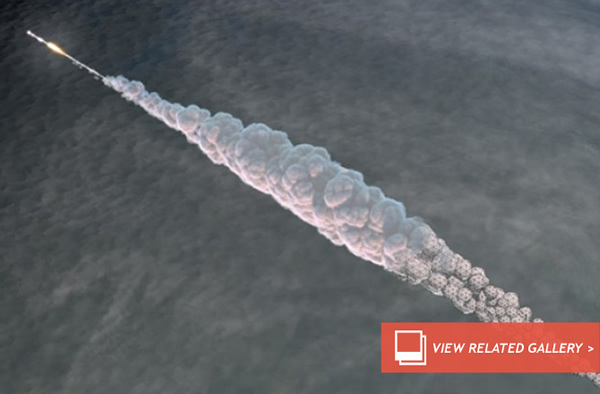Russian Meteor: Small Asteroid Impacts More Likely
When a 12,000-13,000 ton chunk of space rock slammed into the skies over the Urals region of Russia during the morning commute on Feb. 15, the population of Chelyabinsk would have been forgiven in thinking their city was about to get pulverized. The meteor, however, disintegrated and generated a powerful airburst high in the atmosphere — unleashing the equivalent energy of 500 kilotons of TNT — blasting the ground with a shock wave that caused nearly 1,500 injuries and millions of dollars of property damage.
This ‘rare’ event was captured by hundreds of CCTV cameras and dash cams, prompting a surge of YouTube videos and world-wide shock. But just how common are ‘superbolides’ like the one that rocked the Russian city? As it turns out, according to research published on Wednesday, being a cosmic target is likely a lot more common than we thought.
Eyewitness videos, ground-based seismometers and infrasound detectors have given astronomers and asteroid experts a wealth of data on the Chelyabinsk event. The meteoroid’s mass, its trajectory, its composition, even its origin have been deduced. And now, according to the scientists behind the first published research papers on the Russian meteor, these events probably happen far more frequently than originally believed — up to 10 times more frequent.
In the new three papers (two published in the journal Nature and one published in Science), asteroid investigators used the wealth of eyewitness data to determine that as the space rock traveled through the atmosphere, it began to fracture and disintegrate at an altitude of between 45-30 kilometers (28-19 miles). As it entered the atmosphere, it was traveling at the breakneck speed of 19 kilometers (12 miles) per second. The main mass of the meteor burst into a cloud of gas, dust and debris at an altitude of 27 kilometers (17 miles) with the energy thirty times that of the atomic bomb that was dropped on the Japanese city of Hiroshima in 1945. It was at this altitude that the devastating shockwave was generated.
“Luckily, most of the kinetic energy was absorbed by the atmosphere,” said Jiří Borovička, an asteroid researcher at the Astronomical Institute, at the Academy of Sciences of the Czech Republic in Ondřejov, near Prague. “A more solid rock that might have blasted closer to the ground would have caused considerably more damage.”
Meteorites from the fireball were also recovered from the ground, including a large 570 kilogram (1,257 lb) chunk that was pulled from a nearby lake. Analysis of the mineral content indicates that the meteoroid was an ordinary an ordinary chondrite. Furthermore, through analysis of the meteor’s trajectory has shown that it likely originated from the main asteroid belt that is located between the orbits of Mars and Jupiter.
As Discovery News reported in August, astronomers voiced the possibility that the Chelyabinsk meteoroid may be a part of an asteroid “gang” orbiting the sun on a common trajectory, possibly fragments from another, larger asteroid. According to the three publications, this is cited as a distinct possibility.
According to one of the Nature papers, the modeled orbital trajectory of the Chelyabinsk meteoroid is strikingly similar to the 2 kilometer-wide asteroid (86039) 1999 NC43. “This is hardly a coincidence,” says Borovička. (In August, however, astronomers had identified “the most probable parent body” for the Chelyabinsk meteor as 150-330 meter-wide asteroid 2011 EO40.)
The orbits of the vast majority of asteroids over 1 kilometer in diameter are very well known, but as asteroids get smaller, we venture into uncertain territory. “The residual impact risk — from asteroids with yet-unknown orbits — is shifting to small-sized objects,” said planetary scientist Peter Brown, at the University of Western Ontario in London, Canada.
Previously, models predicted the impact frequency of Chelyabinsk-sized meteors to be approximately one every 150 years, but as Brown points out, from the data collected around this Russian meteor event and other small recent atmospheric impacts, this estimate is likely inaccurate. The upshot from this new research is that, on average, we should expect a Chelyabinsk-sized event once every 25 years at least.
It is worth highlighting, that while interesting, this doesn’t mean that we can expect a city to get hit, on average, once every couple of decades. 70 percent of the planet is ocean and the majority of the rest is unpopulated regions, so events like Chelyabinsk are rare in that metropolitan regions are a relatively small target. So, although this research adds some valuable detail to the complexities of asteroid impact risk, there’s no reason to worry unduly.
For me, this research has highlighted how social media and the surge of availability of comparatively cheap cameras can contribute greatly to the scientific process. The amazing wealth of YouTube videos from the morning of Feb. 15 in and around Chelyabinsk gave the world a ringside seat in what it feels like to be at the receiving end of a powerful cosmic strike.
“Calculating meteor trajectories isn’t easy physics by any means,” said Timothy Spahr, director of the Smithsonian Astrophysical Observatory’s Minor Planet Center in Cambridge, Mass. “I’m stunned at how the fairly good-quality YouTube videos have enabled such beautiful science.”
Image: Artist’s impression of the Russian meteor entering the Earth’s atmosphere. Credit: Andrea Carvey, Mark Boslough & Brad Carvey(Nov 7, 2013 04:44 PM ET // by Ian O'Neill)












